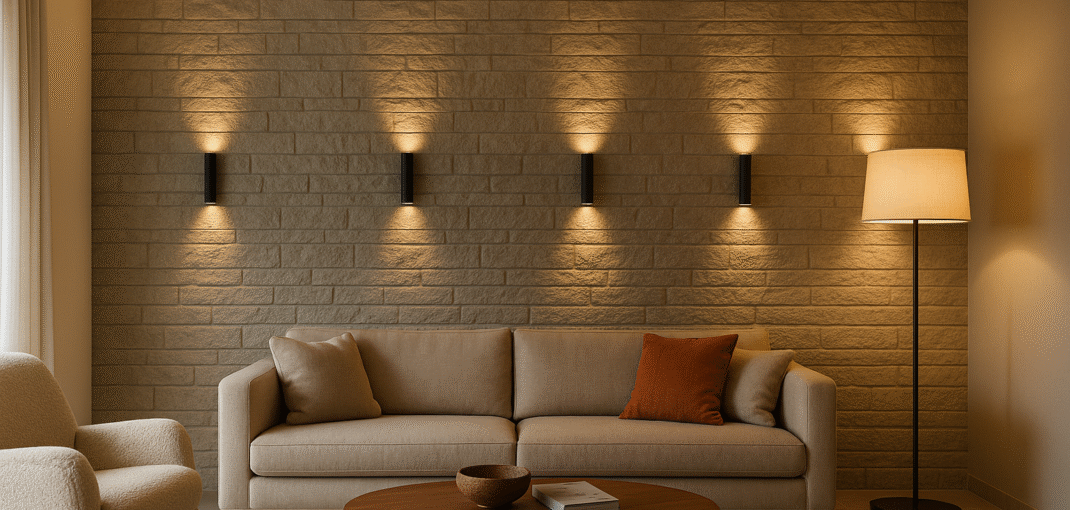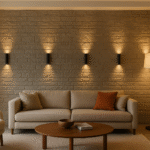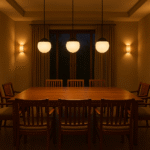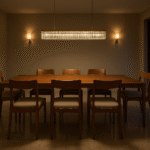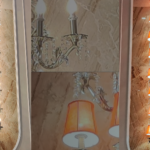Wall Lights in India
Pick wall lights with three decisions in mind: mounting height, spacing, and brightness. Use the rules below to place cozy bedroom wall lights, striking living room sconces, and clean up–down wall lights that paint the wall without glare.
Quick start for Wall Lighting: Height x Spacing x Wattage
1) Pick the job
- Ambient: soft, general glow (opal glass or fabric shades).
- Task: focused light for reading or grooming (aimed or shielded).
- Accent: dramatic up–down beams to highlight texture, niches, and art.
2) Choose the beam
- Up–down: sends light both ways for tall hourglass beams.
- Diffused: opal or fabric shades for gentle, glare-free spread.
- Wall-wash: asymmetric optics that push light across a surface.
3) Lock light quality
- Color temperature (CCT): 2700 to 3000 K feels warm for bedrooms and lounges.
- Color rendering (CRI): 90 or higher keeps skin tones and fabrics true.
- Dimming: add dimmers so you can flip from movie mode to cleaning mode.
Bedroom wall lighting: height, reach, and control
Mounting height
Place the sconce center about 15 to 25 cm (6 to 10 inches) above the top of the mattress so light clears pillows but stays easy to reach. This usually lands the centerline around 95 to 110 cm from the floor, depending on mattress height.
Left–right placement
Set each sconce 20 to 40 cm from the bed edge, or center over each nightstand, so the beam hits your book, not your eyes.
Swing-arm vs fixed
- Swing-arm: best for readers; aimable and low-glare.
- Fixed: cleaner look; choose down-tilted shades, cone reflectors, or cutoff baffles to direct light.
Comfort tips
Use 2700 K for relaxation. Add a night level at about 5 to 10 percent on a dimmer. Frosted diffusers and deep housings hide LED dots. Avoid bare filaments if walls or mirrors are glossy.
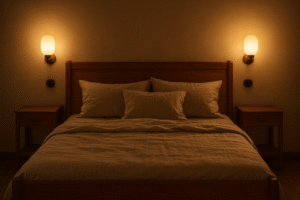
Living room wall lighting: TV walls, corridors, seating
Mounting height
Set centers at 150 to 165 cm (59 to 65 inches). In rooms with 10 to 12 foot ceilings, you can raise slightly.
Spacing
Start with 1.5 to 2.4 metres (5 to 8 feet) between fixtures for medium beams. Tighten spacing on dark walls or with narrow beams.
Layering
Let wall lights shape the backdrop. Use floor and table lamps for faces and books. A soft cove or a few recessed downlights can top up ambient so sconces run at lower, more comfortable levels.
Up–down beams: what do the angles do?
- Narrow, about 10 to 20 degrees: tall, dramatic streaks; great on stone and fluted panels.
- Medium, about 30 to 40 degrees: versatile “lantern” look with controlled spill.
- Wide, about 60 degrees and above: soft edges for corridors and TV walls.
Tighter beams boost contrast and show texture. Wider beams smooth shadows for calm, hotel-like ambience. On rough stone or brick, a medium up–down beam reveals depth without harsh scallops.
Finishes and materials
- Satin brass warms teak and Indian stone.
- Oil-rubbed bronze suits heritage or Art Deco themes.
- Polished nickel or chrome gives clean, modern sparkle.
- Matte black outlines geometry and hides dust.
- Opal glass = soft glow. Clear or smoked glass = sparkle (watch glare).
Coastal and humid care
In Mumbai, Chennai, Goa and similar climates, choose powder-coated or lacquer-sealed finishes. For bathrooms and vanities, look for IP44 or better and seal around backplates. Wipe with a dry microfiber and avoid strong solvents.
Brightness and wattage: simple targets, amazing results
Think in lumens first; wattage varies by LED.
| Room / Use | Per-fixture lumens | Typical LED wattage* | Notes |
|---|---|---|---|
| Bedside reading | 300 to 600 | 4 to 7 | Narrow or medium beam, dimmable |
| Bedroom ambient sconce | 400 to 800 | 6 to 8 | Diffused shade, 2700 K |
| Living accent (up–down) | 500 to 900 | 7 to 10 | Medium beam for texture |
| Corridor or foyer | 400 to 700 | 5 to 8 | Wide beam for even glow |
| Vanity / side of mirror | 600 to 900 | 7 to 10 | CRI 90 or higher |
*Indicative only. Always check the fixture’s lumen output.
CCT and CRI guide
| Zone | CCT (K) | CRI | Why |
|---|---|---|---|
| Bedrooms | 2700 to 3000 | ≥90 | Cozy and flattering |
| Living / TV | 2700 to 3000 | ≥90 | Warm ambience, less strain |
| Corridors | 2700 to 3000 | ≥90 | Seamless flow |
| Vanity | 3000 to 3500 | ≥90 | Natural skin tones |
For lighting basics like lumens, CRI, and CCT, see the Illuminating Engineering Society at ies.org.
Electrical basics in India: 220 to 240 V, lamps, drivers
- Lamp bases: decorative sconces often use E27 (screw) or B22 (bayonet). Compact heads may use GU10 or G9. Confirm watt limits and heat.
- Integrated LED: many sconces include drivers; if you plan to dim, make sure the driver is dimmable.
- Dimmers: most residential dimmers are TRIAC (phase-cut). Pair only with compatible drivers or lamps. For very smooth low levels and scenes, use 0–10 V or DALI with matching gear.
Installation and safety
Fix to a rated metal box or solid anchor—never to gypsum alone. For gypsum or POP walls, add ply backing or a metal frame behind the board. Hide excess wire in the backbox, leave a service loop, and label neutral and earth. Keep sconces clear of curtains and headboards to prevent heat build-up. Plan conduit exits so the backplate covers the hole. If drivers are remote, provide an accessible hatch.
Style lookbook: nine modern ideas for Wall Lighting
- Brass up–down blade: slim baton in satin brass casting tall hourglass beams on textured walls.
- Opal glass twins: rounded globes flanking the bed for instant hotel calm.
- Matte black lantern: deep-set LEDs with cutoff—perfect for TV walls.
- Smoked glass cone: mid-century accent over walnut paneling.
- Rattan and brass mix: warm tropical texture for verandas (use IP44 if semi-outdoor).
- Prismatic vanity bars: vertical on both sides of the mirror for even faces.
- Stone-wash up–down: narrow beams grazing slate or fluted plaster.
- Fabric shade with dimmer: soft, diffused bedroom glow—great for rentals.
- Linear wall-wash: asymmetric optic washing a gallery wall of photos.
Budget map: where to spend vs save
- Spend on: high-CRI LEDs or lamps, reliable drivers, good optics, and durable finishes (lacquer or powder-coat).
- Save on: over-complex forms. Simple geometry at the right height looks premium.
- Mix one statement up–down piece on the feature wall with simpler diffused sconces elsewhere.
Common mistakes and easy fixes
- Too high or low: bedrooms—center about 15 to 25 cm above mattress top; living rooms—centers around 150 to 165 cm.
- Harsh glare: use opal or frosted shades, deep baffles, or dim to about 60 to 70 percent.
- Patchy walls: choose wider beams or add fixtures at 1.5 to 2.4 metre spacing.
- Wrong color feel: move from 4000 K to 3000 K and keep CRI 90 or higher.
- Flicker on dimming: match dimmer type to the driver or lamp; consider 0–10 V for ultra-smooth low levels.
FAQs — Wall lights in India
1) What height should bedroom wall lights sit at?
Mount the center about 15 to 25 cm above the mattress top, often 95 to 110 cm from the floor. Adjust to your bed height and pillow stack.
2) How far apart should living room wall lights be?
Start at 1.5 to 2.4 metres for medium beams. Tighten spacing for dark walls or narrow beams.
3) Are up–down fixtures enough for ambient light?
They are great for accent and perimeter ambience. For full ambient, layer with floor or table lamps or a cove.
4) Which bulbs suit modern sconces?
High-CRI (90 or higher) LEDs at 2700 to 3000 K. Use frosted LEDs for exposed lamps to cut glare.
5) Can I dim every wall light?
Only if the lamp or driver is dimmable and your dimmer type matches (TRIAC versus 0–10 V or DALI). Check the datasheet.
6) What finishes last in coastal Indian cities?
Powder-coated aluminum or lacquer-sealed brass. Wipe monthly to fight humidity and salt air.
7) Are wall lights safe near curtains or wood paneling?
Yes—with LED sources, a rated back box, and proper clearance. Avoid trapping heat.
8) Where can I learn the basics?
See the Illuminating Engineering Society at ies.org.
Conclusion
Lock the basics—height, spacing, and brightness—and wall lights become easy. In bedrooms, mount just above the mattress top with warm, dimmable light. In living rooms, keep centers around 150 to 165 cm and space 1.5 to 2.4 metres apart, using up–down beams to sculpt texture. Choose finishes that fit your décor and climate, aim for CRI 90 or higher at 2700 to 3000 K, and pair fixtures with the right dimmer. The result: modern wall sconces that look premium, feel relaxing, and work every day.

